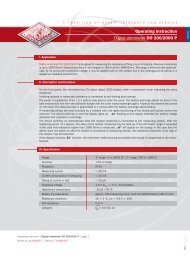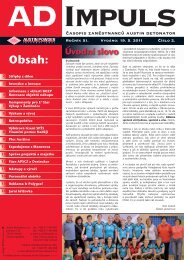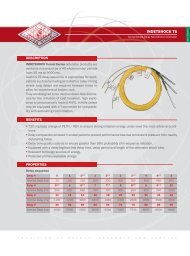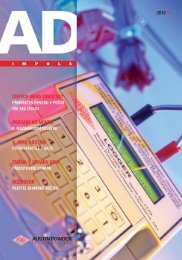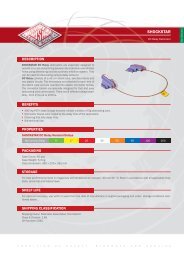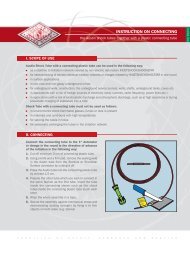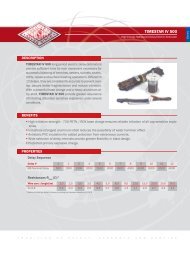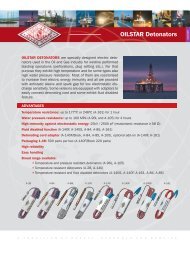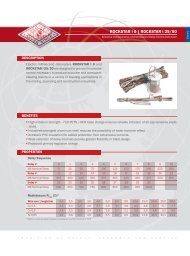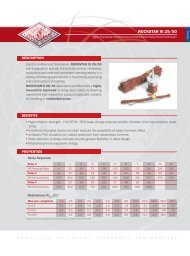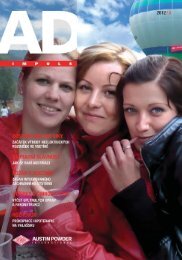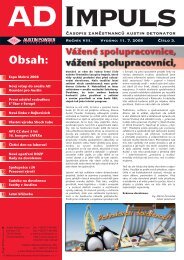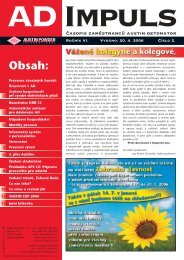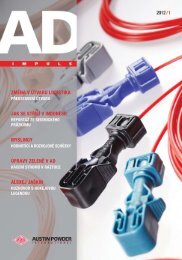User's Guide - Austin Detonator sro
User's Guide - Austin Detonator sro
User's Guide - Austin Detonator sro
You also want an ePaper? Increase the reach of your titles
YUMPU automatically turns print PDFs into web optimized ePapers that Google loves.
WARNINGS AND INSTRUCTIONS<br />
All explosive materials are dangerous and must be carefully handled and used following approved safety procedures either by or under<br />
the direction of competent, trained, and experienced persons, and in accordance with applicable state and local laws, regulations and<br />
ordinances. If, after carefully reading this entire leaflet, you have any questions or doubts as to how to use any explosive product, do not<br />
use it before consulting your supervisor, or <strong>Austin</strong> <strong>Detonator</strong>. If your supervisor has any questions or doubts, he should consult <strong>Austin</strong><br />
<strong>Detonator</strong> before use.<br />
READ AND HEED THESE WARNING AND INSTRUCTIONS<br />
Storing and transporting electric detonators<br />
General<br />
•<br />
Always separate magazine from other magazines, buildings where<br />
persons might dwell, highways, and passenger railways.<br />
Be sure magazines are securely locked, and protected from<br />
weather, fire and theft.<br />
Keep the inside of the magazine clean, dry, cool and well<br />
ventilated.<br />
Always follow state and local laws and regulations concerning<br />
transportation.<br />
Use care when loading and unloading detonators.<br />
When transporting the detonators using motor vehicles, transport<br />
the detonators in their original packing.<br />
Transport only the required amount of explosives and detonators<br />
to the blast area.<br />
Always rotate stocks of explosive material so the oldest material<br />
in the magazine is used first.<br />
Keep explosives and detonators separate until the last possible<br />
moment.<br />
Never allow lighters, matches, open flame or other sources of<br />
ignition within 15 meters of the magazine.<br />
Don’t store detonators with other explosive material.<br />
Never exceed recommended storage quantity, time and temperature<br />
for detonators.<br />
<strong>Detonator</strong> must be stored in the environment with relative humidity<br />
not exceeding 80% and temperatures between -30°C<br />
and +40°C.<br />
Do not leave a vehicle containing detonators unattended.<br />
•<br />
•<br />
•<br />
•<br />
•<br />
•<br />
•<br />
•<br />
•<br />
•<br />
•<br />
•<br />
•<br />
Shipping classification<br />
<strong>Detonator</strong>s are classified for shipment as Class 1, Division 4B<br />
and 4S, UN number 0255 and 0456. The classification is for<br />
railway, sea, road, and air transportation as per RID, ADR, ADN,<br />
IMDG-CODE and IATA-DGR.<br />
Marks and packaging<br />
<strong>Detonator</strong>s are shipped in fibreboard cases, one box contains 5<br />
or 10 inner boxes, depending on the size of case. <strong>Detonator</strong>s are<br />
packed in inner boxes, each containing maximum of 100 Pcs (2<br />
m leg wires length detonators). Quantity of detonators depends on<br />
the length of leg wires. Cases are marked with labels carrying the<br />
product identification, ID number and Class and Division Code.<br />
Shelf life and warranty<br />
<strong>Detonator</strong>s shelf life is 24 months from the date of manufacture<br />
provided they are stored in the environment with temperatures<br />
between -30°C and +40°C. Warranty period is 24 months from<br />
the date of shipment.<br />
Handling electric detonators<br />
General<br />
•<br />
•<br />
•<br />
•<br />
Keep explosive materials away from children, unauthorized<br />
persons and livestock.<br />
Carry out the blasts under the supervision of a shotfirer.<br />
The shotfirer is responsible for firing the round.<br />
Don’t allow any lighters, matches, open flame or other sources<br />
of ignition in the blasting area.<br />
Always use permissible detonators (COALSTAR and/or TIMESTAR<br />
Cu shell execution) in flammable, gassy, or dusty environments,<br />
wherever required by applicable local laws and regulation.<br />
Never split the detonator open or use any other method to<br />
dissect and examine the inside of the detonator.<br />
•<br />
•<br />
Application and use of Electric <strong>Detonator</strong>s<br />
ROCKSTAR, TIMESTAR, SEISMICSTAR detonators can be used<br />
in the following:<br />
• Open-pit mines.<br />
• Non-gassy, non-coal underground mines.<br />
• Gassy coal mines for coal and rock quarry (TIMESTAR Cu shell<br />
execution only).<br />
• Underground construction and lots not intended for use in<br />
underground coal mining (for example: tunnels, shafts, wells,<br />
underground containers, underground redevelopment construction,<br />
caves).<br />
ROCKSTAR, TIMESTAR, SEISMICSTAR detonators may not be<br />
used in the following:<br />
• Environments with explosive gasses, fumes, or dust where no<br />
concentration limit for the explosive gasses has been determined<br />
for blasting work. The fumes, gasses, or dust contained in<br />
a given environment are not considered explosive provided they<br />
do not reach the concentration needed for their initiation.<br />
• Materials in which use of detonators may cause fire or explosion.



